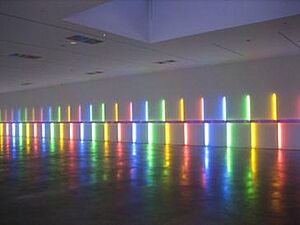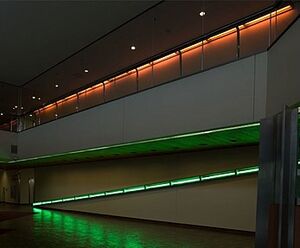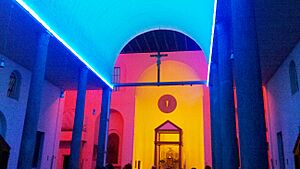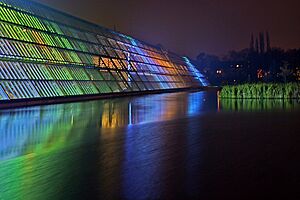Dan Flavin facts for kids
Quick facts for kids
Dan Flavin
|
|
|---|---|
| Born |
Daniel Nicholas Flavin Jr.
April 1, 1933 |
| Died | November 29, 1996 (aged 63) |
| Nationality | American |
| Education | Columbia University |
| Style | Installation art Sculpture Site-specific installation art |
| Spouse(s) |
|

Dan Flavin (born April 1, 1933 – died November 29, 1996) was an American artist. He was known for creating art using ordinary fluorescent light tubes. His art often involved setting up these lights in specific ways to create sculptures and fill rooms with light and color. He was a key artist in the Minimalist art movement.
Contents
Early Life and Art Journey
Daniel Nicholas Flavin Jr. was born in Jamaica, New York. He grew up in an Irish Catholic family and went to Catholic schools. For a few years, from 1947 to 1952, he even studied to become a priest.
After leaving the seminary, he joined the United States Air Force in 1954. While in the military, he started studying art. When he returned to New York in 1956, he continued his art studies at different schools, including Columbia University.
From 1959, Flavin worked at famous art museums like the Guggenheim Museum and the Museum of Modern Art. He met other artists there, like Sol LeWitt and Robert Ryman.
Family Life
In 1961, Dan Flavin married Sonja Severdija. They later divorced in 1979. His twin brother, David, sadly passed away in 1962.
Flavin married his second wife, artist Tracy Harris, in 1992. He died in Riverhead, New York, in 1996. A special event was held to remember him at the Dia Art Foundation.
Dan Flavin's Artworks
First Art Ideas
Flavin's early art included drawings and paintings. He also made collages using everyday items he found, like crushed cans.
In 1961, he started sketching ideas for sculptures that used electric lights. His first works with light were called the "Icons" series. These were box-like shapes made from wood or other materials. They had fluorescent tubes and light bulbs attached to them. One of these "Icons" was made in memory of his twin brother, David.
Famous Light Art
In 1963, Flavin created Diagonal of Personal Ecstasy. This was a yellow fluorescent light placed on a wall at an angle. This artwork was important because it was the first time Flavin used only store-bought fluorescent lights for his art. From then on, he only used specific colors like red, blue, green, pink, yellow, ultraviolet, and different whites. He also used only straight tubes of certain lengths or circles.
Over the years, he kept exploring how light and color could fill a space. He created art that was meant for specific places, often called "site-specific" art. These artworks would cast both light and colored shadows. They took many forms, like "corner pieces" or "corridors."
Many of Flavin's works had simple titles, often followed by a dedication to friends or other artists. A famous series was his Monuments to V. Tatlin. These were pyramid-shaped wall pieces made between 1964 and 1990. They honored a Russian artist named Vladimir Tatlin.
In 1966, Flavin made his first full light installation called greens crossing greens. This was for an exhibition in the Netherlands. His "corridors" were artworks that guided or blocked how people moved through a gallery. For example, untitled (to Jan and Ron Greenberg) from 1973 used green and yellow lights to create a dividing wall.
By 1968, Flavin's sculptures grew to fill entire rooms with light. In 1992, a large artwork he designed in 1971 was finally built. It filled the whole round main area of the Solomon R. Guggenheim Museum.
Flavin usually planned his sculptures in sets of three or five. However, he would only build them when someone bought them. This saved on production and storage costs. Because of this, he had over 1,000 unbuilt artworks when he passed away.
Art That Stays Forever

Starting in 1975, Flavin created permanent artworks in different places. These are artworks that are meant to stay in one location. Some examples include works at the Kunstmuseum Basel in Switzerland and the Kröller-Müller Museum in the Netherlands. He also created art for the MetroTech Center in Brooklyn, New York, and the Hypovereinsbank in Munich, Germany.
His last artwork was a special piece for the Santa Maria Annunciata in Chiesa Rossa church in Milan, Italy. He finished the design just two days before he died in 1996. The artwork was installed a year later.
The Menil Collection in Houston, Texas, also has a permanent light installation by Flavin. He completed the design for this space right before his death.
The Dia Bridgehampton museum in Bridgehampton, New York, opened in 1983 as the Dan Flavin Art Institute. It has nine of Flavin's fluorescent light artworks on permanent display.
Drawings and Collections
Flavin also enjoyed drawing the landscapes around his homes in New York. He drew portraits and kept many journals. He collected drawings by other artists too, including Japanese artists like Hokusai and European masters like Piet Mondrian. He also traded artworks with his friends, like Donald Judd.
Art Shows and Exhibitions
Flavin's first art show using only fluorescent light was in 1964. His first big museum show was in 1967 at the Museum of Contemporary Art, Chicago.
A very important show of his work was organized in 1969 at the National Gallery of Canada. In 2006, the Dia Art Foundation and the National Gallery of Art put together a huge exhibition called Dan Flavin: A Retrospective. This show brought together more than 50 of his artworks.
Dan Flavin: A Retrospective (2004 – 2007)
This large exhibition traveled to many museums between 2004 and 2007. It was the first big show that looked at all of his minimalist light art. It included about 45 light works, including his "icons" series. The show helped many people see and understand his unique art.
Awards and Honors
In 1964, Flavin received an award from the William and Norma Copley Foundation. This award was recommended by the famous artist Marcel Duchamp.
In 1983, the Dia Art Foundation opened the Dan Flavin Art Institute in Bridgehampton, New York. This is a special place where his artworks are shown permanently. Flavin helped design the space himself. The museum used to be an African-American church. It now displays nine of his all-fluorescent pieces.
In 2011, for the movie Tower Heist, Flavin's family sent an expert to make sure a Flavin light installation was built correctly for the film set.
See also
 In Spanish: Dan Flavin para niños
In Spanish: Dan Flavin para niños
- Santa Maria Annunciata in Chiesa Rossa in Milan, Italy, Flavin's final work.



